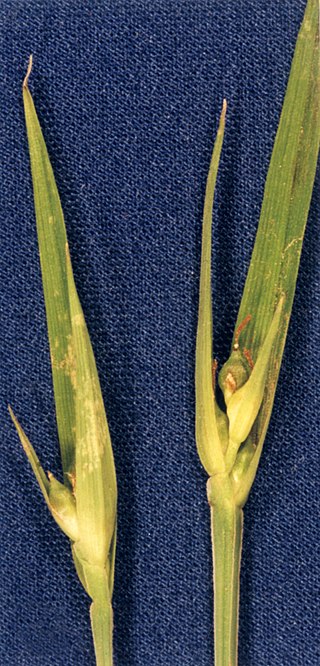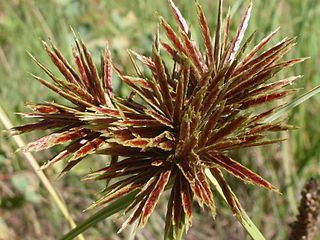
Carex flacca, with common names blue sedge, gray carex, glaucous sedge, or carnation-grass,, is a species of sedge native to parts of Europe and North Africa. It is frequent in a range of habitats, including grasslands, moorlands, exposed and disturbed soil, and the upper edges of salt marshes. It has naturalized in eastern North America.

Uncinia is a genus of flowering plants in the family Cyperaceae, known as hook-sedges in Australia and as hook grasses or bastard grasses in New Zealand. The genus is characterised by the presence of a long hook formed by an extension of the rachilla, which is used to attach the fruit to passing animals (epizoochory), especially birds, and it is this feature which gives the genus its name, from the Latin uncinus, meaning a hook or barb.

Carex rossii, commonly known as Ross's sedge, is a hardy species of sedge that is often a pioneer species in areas with little or no established vegetation, or in places where disturbance has occurred. Ross's sedge grows in a variety of habitats throughout much of western North America, from Alaska to Ontario, south to New Mexico and California. It flowers in May and June.

Carex binervis, the green-ribbed sedge, is a European species of sedge with an Atlantic distribution. It is found from Fennoscandia to the Iberian Peninsula, and occurs in heaths, moorland and other damp, acidic environments. It typically grows to a height of 15–120 cm (6–50 in), and has inflorescences comprising one male and several female spikes, each up to 45 mm (1.8 in) long. The utricles have two conspicuous green veins, which give rise to both the scientific name and the common name of the species. In the vegetative state, it closely resembles C. bigelowii, a species that usually grows at higher altitude. C. binervis was first described by James Edward Smith in 1800, and is classified in Carex sect. Spirostachyae; several hybrids with other Carex species are known.

Carex spicata is a species of sedge in the genus Carex.

Carex pilulifera, the pill sedge, is a European species of sedge found in acid heaths, woods and grassland from Macaronesia to Scandinavia. It grows up to 30 cm (12 in) tall, with 2–4 female spikes and 1 male spike in an inflorescence. These stalks bend as the seeds ripen, and the seeds are collected and dispersed by ants of the species Myrmica ruginodis.

Carex distans, commonly known as distant sedge, is a plant species in the sedge family, Cyperaceae. It is native to Europe and North Africa. It is part of a complex of similar species that occur across Eurasia. Its relatives include Carex diluta of central Asia, which has also introduced to North America in Montana. C. distans has been introduced to US states including Maryland and Pennsylvania. More recently, it was found in Oregon. There is a report from Victoria, Australia as well.

Carex longebrachiata, commonly known as Australian sedge or drooping sedge, is a plant species in the sedge family, Cyperaceae. It is native to Australia.

Carex lacustris, known as lake sedge, is a tufted grass-like perennial of the sedge family (Cyperaceae), native to southern Canada and the northern United States. C. lacustris us an herbaceous surface-piercing plant that grows in water up to 50 cm (1.6 ft) deep, and grows 50–150 cm (1.6–4.9 ft) tall. It grows well in marshes and swampy woods of the boreal forest, along river and lake shores, in ditches, marshes, swamps, and other wetland habitat. It grows on muck, sedge peat, wet sand or silt, in filtered or full sunlight.
Carex acaulis, known as the small dusky sedge, is a species of sedge in the genus Carex native to the Falkland Islands and southern Argentina.

Carex backii, commonly known as Back's sedge, is a species of sedge (Carex) in the section Phyllostachyae. First described scientifically in 1839 by American botanist Francis Boott, it is found in Canada and the United States, where it grows in shaded woods, shaded slopes, and shrub thickets.

Carex capillacea, common name yellowleaf sedge in Tasmania, is a species of sedge found in Assam, the far east of Russia, New Guinea, south east Australia, New Zealand, Malesia, China, Japan and India.

Carex appressa, the tall sedge, is a species of flowering plant in the family Cyperaceae. It is native to New Guinea, Australia, New Zealand, and generally in the South West Pacific.

Carex fascicularis, commonly known as tassel sedge, is a species of sedge of the family Cyperaceae that is native to Australia, New Zealand and New Guinea.
Carex tereticaulis, also known as basket sedge, is a species of sedge of the family Cyperaceae that is native to southern parts of Western Australia, southern parts of South Australia, southern and eastern parts of New South Wales as well as north western and central Victoria and Tasmania. The Koori peoples know the plant as Poong'ort.

Cyperus congestus, commonly known as dense flat-sedge or clustered flat-sedge, is a sedge of the family Cyperaceae that is native to southern Africa mostly in South Africa, Lesotho and Namibia.

Carex muehlenbergii is a species of flowering plant, it is a type of sedge. It is a grass-like plant in the family Cyperaceae. Its common names include sand sedge, Muhlenberg's sedge.

Carex gaudichaudiana, also known as fen sedge, is a tussock-forming species of perennial sedge in the family Cyperaceae. It is native to parts of Australia and New Zealand.
Carex interrupta is a tussock-forming species of perennial sedge in the family Cyperaceae. It is native to south eastern parts of Canada and north eastern parts of the United States.
Carex cephalotes, also known as wire-head sedge, is a tussock-forming species of perennial sedge in the family Cyperaceae. It is native to south eastern Australia and New Zealand.
















